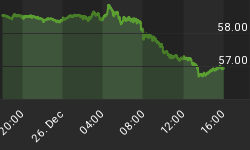Housing starts dropped in November to 1.187 million. Analysts pointed out that housing starts appear to have bottomed. While November starts were below October, they were above September's fifteen- year low. Building permits, however, made a new low last month at 1.152 million. This was not only the lowest level since June 1003, but 49% off the high.
This flattening of demand seems to have tempered the pessimism of the homebuilders. The National Association of Home Builders latest survey was unchanged from November, but the composition of the index changed. Builders actually got a little more optimistic regarding both present sales (up one point to 19) and future sales (up two points to 24), but the traffic component dropped three points offsetting those gains. Geographically, the only area that was weaker in December was the Northeast (down 7 points to 19). The West was flat and the Midwest and South were both up two points to 15 and 21, respectively.
Following last Thursday's release of producer prices, the Labor Department reported that consumer prices jumped 0.8% in November, which was larger than the 0.6% increase economists were expecting and excluding the spike following Hurricane Katrina, was the largest monthly increase since August 1990, when Iraq invaded Kuwait. The year-over-year change was 4.3%. This also was higher than expectations of 4.1%. If there is no inflation this month, the year over year change will be 3.8%. Considering the monthly change has averaged 0.4% this year, it's likely the year-over-year change in consumer prices next month will be over 4%. This will be the first time since 1990 that the calendar year increase in consumer prices was greater than 4%.
The number of economists that point to the "core" rate of inflation has dropped significantly. We have pointed out earlier this year that focusing on the core rate can be useful and analytically correct when the changes in food and energy prices are volatile in both directions, but when the two are clearly trending upward that is the story that needs to be focused on and not simply cast aside.
These two items have not only impacted consumer prices, but have impacted corporate earnings as well. On Wednesday, Darden Restaurants, owner of Red Lobster and Olive Garden restaurants, among a few others, commented that higher food costs, namely dairy, bread and seafood, negatively impacted margins. Additionally, the company buys its wheat-related products (bread and pasta) under longer-term supply agreements, of which some are currently being negotiated. Wheat is currently trading at an all-time high and is almost double the price it was last year. The company did maintain its same store sale growth guidance of 2-4%, "but more in the lower to middle part of the range given the current consumer environment." On the energy side, Union Pacific, the country's largest railroad, announced it will earn $1.70 to $1.80 per share during the fourth quarter. This was twenty cents lower than previous guidance.
Inflation is not a threat anymore, its here. Corporate margins are at a record high level and will be under pressure from rising cost, but from lower sales volumes as economic growth slides and likely heads into recession. Stagflation has started to be discussed recently as economic growth has slowed as prices have accelerating. While the inflation levels of the late 70s are not anticipated, it's likely that asset prices, namely real estate, will decline while the price of goods and services rise.
Due to the holidays, the next Mid-Week Analysis will be January 9, 2008.
















